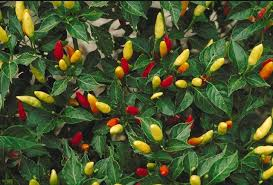
So this year I am growing even more peppers. And after several years of successful pepper growing, I have some favorites.
Jalapeño plants seldom have pest problems and produce peppers early and often. Pickled jalapeños were one of my household's favorite preserves until we discovered how easy it is to make fermented hot sauce. Vibrant red or green jalapeños, salt, garlic, a little time in the kitchen and a couple of weeks fermenting in the jar produced incredibly complex, delicious hot sauces that became instant favorites with family and friends.
I'm planning for at least 20 jalapeño plants this year. With such abundance, we can pick some unripe peppers for green sauce and still have plenty to ripen to red for the garlicky hot sauce we had to dole out too sparingly this year. And we are adding Tabasco peppers to the mix.
My favorite sweet pepper last year was ‘Yellow Marconi.'They are delicious picked green, but ripe yellow ones are worth the wait. These slim tapered peppers reach eight to ten inches in length. They are sweet and crisp when raw, but you can also roast and peel them, dressing them simply with good olive oil and salt. Serve them as an antipasto, or cut in strips and sauté with onions and sausage for a classic Italian main course. Marconis are beautiful in the garden and on the plate, and I have allocated a lot of space for them this year.
‘Quadratod' Asti Rosso' (red) and ‘Quadratod' Asti Giallo' (yellow) are classic sweet bell peppers ideal for salads and cooking. Both stand up to stuffing and baking. At the end of the season, I roast, peel and freeze these peppers for our Thanksgiving antipasto.Marinate them in olive oil with a little fresh garlic, salt and a splash of vinegar.
This year we are trying ‘Jimmy Nardello,' an heirloom from Seed Savers Exchange. The company got the seeds from Nardello himself, who claims that his mother brought them with her when she emigrated from Italy's Basilicata region in 1887.
I have also reserved smaller spaces for Thai peppers, habanero, arbol and other super-hot types. One or two plants of each will satisfy us.
Our ‘Padrón' plants did not have full sun last year and had to stretch for light. The plants topped four feet and were a little rangy but consistently loaded with peppers. This year we will grow ‘Shishito' peppers, too. They are easy to grow and should be picked small and green for eating whole. Quickly roast, fry or grill them with a smattering of salt and olive oil.If you see them on a menu, you can order something else as you will have more in your garden the next day.
With so many pepper options, how to choose? If you're not a cook, you might still enjoy growing multi-colored ornamentals for craft projects or holiday decorations. Or perhaps you need an heirloom pepper for an heirloom family recipe. What you can't eat fresh, you can dry, ferment or freeze for future use. And a favorite pepper plant can be dug up and potted at the end of season to grow indoors through the winter.
Peppers are easy to grow from seed. One of the most extensive offerings comes from Redwood City Seed Company. Craig and Sue Dremann have been collecting pepper seeds since the 1970s and their website offers 24 pages of tips to insure your success.
February is not too early to plant pepper seeds. Plant them as soon as you can. Usefresh seed- starting mix for best results. Moisten the mix and fill trays, flats or shallow pots. Space seeds 1 inch apart and cover with ¼ inch of soil. Keep moist but not wet. Provide bottom heat from a seedling mat or keep them in a warm spot in the kitchen with plenty of light.
When seedlings have four true leaves, transplant to small pots with rich potting soil. Keep them warm and provide plenty of light. You may have to repot seedlings one more time before hardening them off outdoors. Wait untilnights and soil are warm before planting. Peppers do not like cold.
Seed sources for peppers:
www.seedsavers.org
Workshops: U. C. Master Gardeners of Napa County will host a workshop on “Home Vineyard: Part 1” on Saturday, February 27, from 9:30 a.m.to 2:30 p.m. at the University of California Oakville Experimental Station, 1380 Oakville Grade Road, Oakville. What to do, what to look for, and what to plan for in the vineyard between February and August. Workshop will be presented in two parts. The morning (9:30 a.m. to 11:30 a.m.)will be classroom discussion. The afternoon (12:30 p.m. to 2:30 p.m. will be a field trip to a local vineyard.On-line registration (credit card only)
Mail-in/Walk-in registration (cash or check only)
U. C. Master Gardeners of Napa County will host a workshop on “Irrigation Hands On” on Saturday,February 27, from 9:30 a.m.to 11:30 a.m., at the University of California Cooperative Extension office, 1710 Soscol Avenue, Napa. Learn how to modify your current irrigation system to make it more efficient and effective.There will be demonstrations and hands-on learning about irrigation controllers, sprinklers, drip systems, rain water capture and grey water systems. For the hands-on segment, bring garden gloves to protect your fingers and a pair of scissors or garden shears.On-line registration (credit card only); Mail-in/Walk-in registration (cash or check only)
Master Gardeners are volunteers who help the University of California reach the gardening public with home gardening information. U. C. Master Gardeners of Napa County ( http://ucanr.org/ucmgnapa/) are available to answer gardening questions in person or by phone, Monday, Wednesday and Friday, 9 a.m. to Noon, at the U. C. Cooperative Extension office, 1710 Soscol Avenue, Suite 4, Napa, 707-253-4143, or from outside City of Napa toll-free at 877-279-3065. Or e-mail your garden questions by following the guidelines on our web site. Click on Napa, then on Have Garden Questions? Find us on Facebook under UC Master Gardeners of Napa County.